| T O P I C R E V I E W |
| Alchemy2 |
Posted - 06/14/2014 : 21:28:34
Okay, my average BG CPM is around 18-20 for the most part. I recently left a canister with 25g fine activated charcoal, in a sealed bag with a 18000CPM uranium sample (25g). 1 week.
Took it out on Thursday, and obtained 70CPM after removal. Now, using the BG, that's ~50CPM due to Bi/Pb 210 beta most likely. Started at ~40CPM over BG, to 50, then fell off after 2.5h to be only 10-12CPM over BG.
Now the canisters are 110mm round. Our 4011 tubes are 83mmx10mm. That's about 1/25th the solid angle considering a 4pi symmetry of the sample. (solid angles in sr); so, So if we assume that the emissions are uniform, then the activity integrated over the volume is around 25*50 = 6250 Bq. ~ 0.17uCi.
The only thing is that this activity is ~50% of the total, given adsorption/exchange on the carbon substrate. So, 0.34uCi.
The volume is a difficult one to process. Surface area on the carbon is about 500m2/g typical in AC material. 25g*500m2=62500m2 or around 63ML (megaliters). No way under simple conditions to verify how much of this total surface area was affected by 222Ra ab/scriptdsorption so If I assume during the experiment that the total volume of 222Ra is generated by the U ore, then I should have: 7*24*60*18000 = 3x10-17 mol or around .03fmol generated during the 7 days. Since the bag was sealed, any adsorbed 222Ra is in secular equilibrium with the daughter producing the beta/gamma decays readable by my 320+ unit.
Hmmm. okay, pretty heavy stuff for some of you non-science folks. What does it all mean? well, My bag is around 1L in volume, and so my activity in the tin with the carbon adsorbant is I guess about 0.34uCi/L - that gives me 50CPM over baseline or background. Not super quantitative, but close enough to at least KNOW that I am detecting indirectly 222Ra daughter products with the charcoal.
More to come...
|
| 25 L A T E S T R E P L I E S (Newest First) |
| ericmoore |
Posted - 09/25/2020 : 12:49:18
Hi forum, i have been serious challenge with gas in my home air. I have research about it, i was recommended to use radon detectors to know the level. However, I'm new to this device but how can i find the best one from this list. Can anyone recommend a product for me. Besides, i don't know if what i'm seeing is fog bcs, i don't want to invest on a radon later and the end its not the issue. That'll be disappointing. Pls, i really need advice on what i should do so i don't waste money.
|
| njc |
Posted - 02/11/2016 : 08:10:03
I think it is dependent on a number of variables:
- Airflow through the system
- Diameter of filter
- Thickness/material of filter
- Proximity of G-M sensor to filter
- Type and sensitivity of G-M sensor
In my case, I have LOOSELY correlated 39CPM to be 1pCi/L. I ran a 48 hour radon test and got 1.9pCi/L and my average CPM was 74 during that period.
4pCi/L is the EPA action limit, while 2pCi/L is the Consider Action Limit.
I had added those limits to my graph: h**p://geiger.njctech.com/radavg.cfm |
| Distelzombie |
Posted - 02/10/2016 : 09:29:58
I know. I was talking specifically about this case. I mean a value where you should better open a window because to much radon.
I have the same tube installed. (sbt11 a) I tried measuring a piece of tissue that I held in front of a vacuum cleaner. That did not work. The Baloon method does work, though. |
| njc |
Posted - 02/09/2016 : 08:35:40
@Distelzombie:
It really depends on the sensitivity of the detector and the types of radiation it is sensitive to. If you have a M4011 (GMC-300/320) then your background should be less than 50 CPM, probably around 20-30 CPM. I recommend that you do some research on radioactivity and naturally occurring radioactive materials (NORMs). |
| ZLM |
Posted - 02/08/2016 : 21:09:38
We want to keep the CPM as low as possible. OR close to background level. <50 |
| Distelzombie |
Posted - 02/06/2016 : 05:06:31
Do you know how many cpm are dangerous? |
| njc |
Posted - 02/03/2016 : 12:55:47
ZLM: Yes, though it isn't paper, it's more like synthetic fiber. I expect anything that isn't too thick and has good airflow would work. |
| ZLM |
Posted - 02/03/2016 : 12:05:33
Thank you.
So the last picture with a paper is the air filter? |
| njc |
Posted - 02/03/2016 : 07:06:12
The extra fan opening is a mistake and is covered with packing tape. I didn't take it apart to show the inside but it's pretty straight-forward. I used small pieces of velcro on the front and sides of the SBT-11A to affix it to the inside of the box very solidly.
Image Insert:
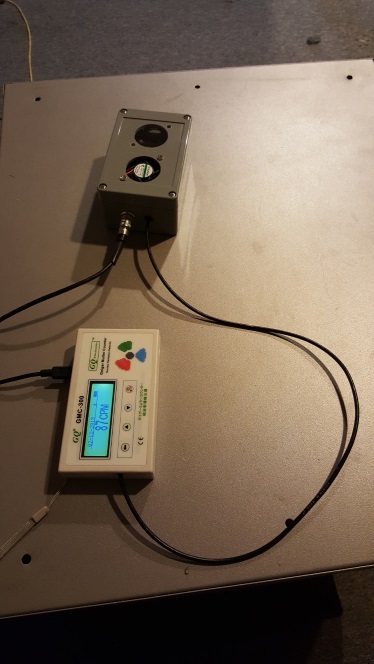
70575 bytes
Image Insert:
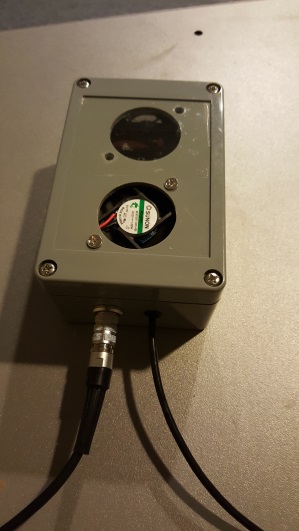
47002 bytes
Image Insert:
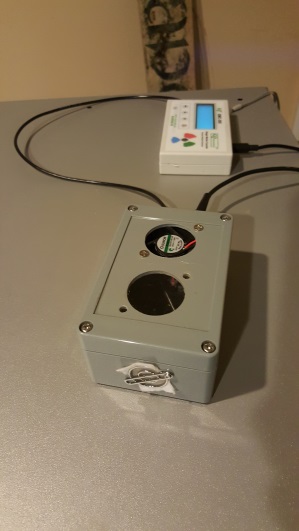
38178 bytes
Image Insert:

43386 bytes |
| ZLM |
Posted - 02/02/2016 : 19:19:43
Good job!
Can you post some photos? |
| njc |
Posted - 02/02/2016 : 11:26:36
I have created a Radon (and daughter particle) detector and logging system for my house. I'm interested in some feedback to what I did and if you agree that it is based on sound science. Here's what I did.
Previously I had written a python app to monitor and log the counts from the GMC-300 to a database (more info http://www.gqelectronicsllc.com/forum/topic.asp?TOPIC_ID=3724).
What I did
I used a small plastic hobby box about 5" x 3". Made a hole on the top and mounted a 5V (USB powered) fan blowing out. On the side I made another hole and mounted a 1" round piece of thin filter media (like from the cheap-o furnace filters). Right behind the filter media on the inside of the box is mounted a SBT-11A which is sensitive to alpha particles. The SBT-11A is run with a short cable to the GMC-300 in place of the M4011.
Does it work?
I know that it works and it's detecting particles in the air. If I turn the fan on, I see a ramp up over about 3 hours and if I turn it off I see a ramp down.
Calibration...maybe?
Once I was confident that the setup was stable and working, I ran a 48-hour canister Radon test (which are known for being somewhat inaccurate). The results came in at 1.9 pCi/L (I have a mitigation system in my house). I took an average of the CPM for the time period the canister test ran and it was 74CPM. This comes out to 1 pCi/L = 39CPM. I think this might be considered "loosely calibrated" if that's not too much of an oxymoronic statement.
Other Thoughts
The CPM during the 48-hour test varied quite a bit, which is not unusual for Radon. I had a high of 115, low of 29 with a standard deviation of 15CPM. I would feel better about the
"calibration" if the levels had been more consistent.
I am pretty confident this setup will let me know of relative Radon level changes but I'm not entirely comfortable with the accuracy.
I may try turning off my mitigation system for a day or so and see how much it goes up. Does anyone have experience with some of the Radon monitors out on the market? Any other thoughts about my project?
Here's a website with the current data presented: http://geiger.njctech.com/radavg.cfm?d=7 (d = days of history to graph) |
| Conundrum |
Posted - 09/07/2015 : 21:19:59
Hi, this is intriguing.
So the idea is to use AC as the radon adsorber, but then measure the daughter products (ie gamma and alpha emitters)
Could you use a very low airflow *through* the AC then compare that with the passive filter?
Also relevant, you can make an alpha sensor by simply using a piece of pyrolytic graphite thinned down over a bare CMOS camera chip.
I've also heard of people using the sensors from HP printers as they are very thin plastic already and probably quite sensitive though the counting efficiency would suck.
Kind regards, -Andre |
| ZLM |
Posted - 08/08/2015 : 20:52:58
I do not worry if the CPM below the 50.
|
| NaCl |
Posted - 08/08/2015 : 19:19:26
I test radon with my 320+ at home. I use vacumm cleaner Samsung model VCMA18AV at lowest suction power operate for 20 minute in living room then remove two of its filters and put it near 320+ sensor for 10 minute time count. The reading swings around 35-50CPM avarge is 39 CPM. Background radiation avarage 10 minute to 5 hrs never exceed 26 CPM, Peak readings never exceed 33CPM even on granite table it is never reach 50CPM.
Other place like my office avarage reading is around 13 CPM. What happen in my house? Is it something to concern? This need a Radon tester? |
| Alchemy2 |
Posted - 10/03/2014 : 15:39:34
I bought over the summer a Radon tester, and indeed Radon is present. It fluctuated from ~130 Bq/m3 to over 330, then back down, and now sits around 202, right on the edge of the action line for Canada. I have a more portable one on order, so I can check other levels around the house before getting my landlord to mitigate this.
I recently got one of Atomic Dave's "Titan" counters off eBay which uses a VERY sensitive Lund 7317 pancake tube. This thing runs over 550CPM off the filter when the furnace has JUST run. I get ~150-160CPM with my "new" 320+ with SBT-11A, and same ~90CPM with the stock 4011 tube.
Certainly, there IS some radon, and since I have seen my levels in the basement jump to just around 200 Bq/m3 this week, my background on the 11A tubed 320+ (lets call it my 320++ ) and titan have gone up. They must be seeing some alpha decay in the air.
Glad to hear your place is radon-reduced. Mine will be before winter hits! |
| madmikeg |
Posted - 10/02/2014 : 20:04:44
My basement was mitigated for Radon when I bought my house 5 years ago, and I have never been able to detect elevated radiation from filters in the house, vacuum cleaner etc. and my basement background reading (concrete block wall, concrete floor) with my GMC 320+ is about 19CPM vs. 17CPM in the main floor of the house. It initially tested at 4.1 pCI/L (151.7 Bq/M3 according to Google). The US EPA recommends action at 4 pCi/L.
|
| Alchemy2 |
Posted - 06/25/2014 : 16:03:12
Well, Radon is confirmed!
225Bq/m3 on a 48h average. So, I'll watch this, but my original suspicions with the furnace filter CPMs using the GQ-320+ were verified.
Now, my challenge is to figure out where this is coming from. It may be a drain near my laundry room, or I may have added some 222 Rn when playing with my Uranium samples. I took care to seal these better and maybe my levels will drop. If they follow around a 4d half life, then I have a better idea where the Rn came from. :)
Since this level is right around the threshold of action suggested by health Canada, I'll keep an eye on it before reacting. We had a LOT of rain last week, and it could have driven some subsurface Radon into the crevices of the foundation here. Stay tuned... |
| Alchemy2 |
Posted - 06/24/2014 : 17:04:34
More fun with Radon...
I ran my furnace today twice, as the first run yielded only a small increase in CPM over background. The second run was about 2.5x background, a far cry form when I did this 7-10 days ago...
Having said that, I am currently running an initial test using a Rn gas detector in my basement. Tomorrow, I'll have the 48h initial readings, which should be interesting. Below is my BG and two count runs after running the furnace. Lots of noise in the CPM for some reason.
Image Insert:
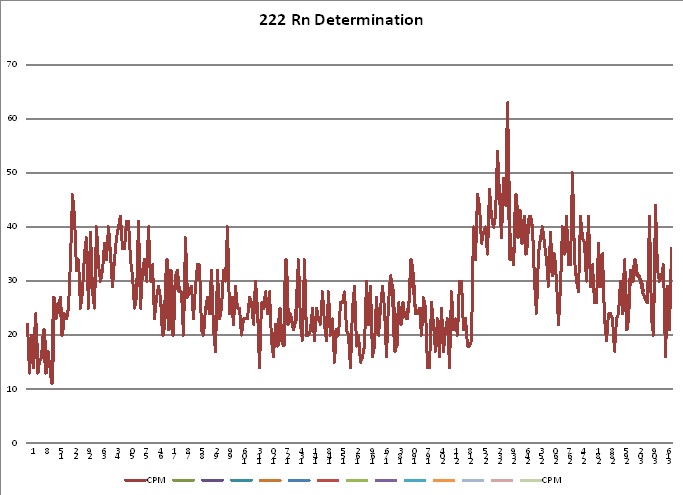
32.09 KB |
| ZLM |
Posted - 06/16/2014 : 21:08:17
Thank you for the information. |
| Alchemy2 |
Posted - 06/16/2014 : 00:14:48
Quick snapshot of graphed data form Radon furnace filter test. early data is BG counts. Note decay in curve over time.
Image Insert:
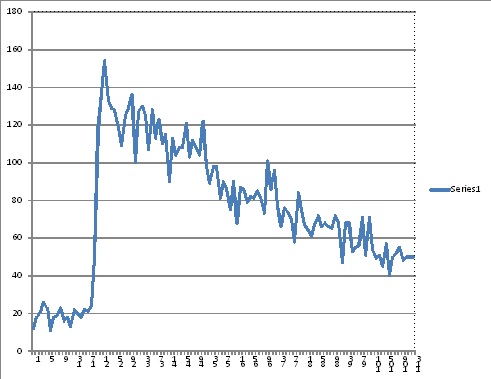
40.67 KB |
| Alchemy2 |
Posted - 06/16/2014 : 00:07:00
350 is the area FACTOR - since the tube is a small fraction of the furnace filter. 70 is CPM above the background, and 2 is the fact that I am reading only the top of the filter, yet radioactivity occurs in random directions in 3D, so one would see a similar reading on the backside of the filter too. Since the filter is fairly shallow compared to the frontal area, it can be somewhat treated like a thin sheet.
I did a retest of this today. 20 minutes of furnace fan running through the filter. BG counts were 22CPM average BEFORE the test. After the fan ceased, I immediately pulled out the filter and placed the 320+ on the center of the filter. Peaks around 140-155CPM, or close to 125CPM over background were seen!! If I assume that the center reading emulates that off the upper side of the filter as a rule, and use 20% efficiency for the tube, then I am seeing around 625CPM approx. off an area of the tube, and technically 2x this assuming similar activity off the underside of the filter, or 1250CPM. A 350x area ratio is also the case here, so assuming fairly uniform absorption of Rn gas onto the filter material, then I get 350*1250CPM = 437500 CPM total est. activity for the filter.
437500CPM is 7291 Bq. If I estimate the 30cfm times 20 min, I get 600cf flow, which is 21.1m3. This yields 172Bq/m3 estimate (assuming 1/2 of the Rn is adsorbed through the filter flow) which is pretty high (Health Canada limits 200 Bq/m3 as a no-activity required, or somewhat normal levels). I may have a Radon problem, though as this is close to the limit, and my estimate assume many things that aren't fully quantified - like cfm rate, adsorption ratio, lack of outgassing considered during test, etc...
I know that these estimates are somewhat way out there. So, I went and ordered a digital Radon meter to evaluate my situation here. It will be interesting to see what the number really is. Nonetheless, the fact that significantly noticeable above background levels are readable with the 320+ during a 20 minute furnace fan run says that there's some non-trivial 222Rn daughter beta activity (most likely due to 210Bi/210Pb products).
THe big trouble with this calculation as is, is that it has estimates that may not be entirely valid. I need to do an element analysis on the area to properly integrate the count number to be representative of an area. Then I'll have a better idea. Also, the degree of adsorption of Radon in the filter is tough to quantify, since it will draw some radon through the filter as well, and some of the Rn may outgas during the measurement.
|
| ZLM |
Posted - 06/15/2014 : 22:39:30
Can you explain more on your 70*350*2 ? I know the 350 is the area. How do you get that value? |
| Alchemy2 |
Posted - 06/15/2014 : 11:44:40
When doing these calculation on the 4.1" dia. tin, I took into account an approximate SOLID angle measurement for the detector. Now, what I DID NOT do was to evaluate the efficiency of the detector counting the betas. So, I most likely am out a bit there. I need to get a calibrated source for that. My U ore sample is 18kBq total, which includes alpha (not det. by Geiger unit), beta and gammas from the ore.
My alternate dosimeter reads as calibrated to Cs137 and is ~20% efficiency. I can get a rough guess there, but If I get my own test source, and factor in geometrical and activity factors for the source, I should be closer to real numbers.
D |
| Alchemy2 |
Posted - 06/15/2014 : 11:36:53
Okay, now guess what? I ran my furnace today for 10 minutes (flow not measured, but have equipment to do so). CPM after fan shut down was 90CPM, or 70 CPM over baseline/BG counts! Oh, Oh... I have 222Ra lurking about. How much? Not sure yet. If I make some rough assumptions, I think I can get a close estimate, though problem is I should really use a new filter for the testing. Meanwhile, 70CPM over BG, or 70Bq, is only a fraction of the surface covered by the filter material, which is 24x16" with 45 degree bends in the HEPA material. Even 90 minutes afterwards, the count was about the same, but then 4h later it's around 1/2 of what it was. So there's definitely decay products absorbed during the furnace running!
If I assume 30cfm, or around ~850Lpm flow over an 10 minute period that the fan was running, then 8500L flowed through the filter. If I assume uniform distribution of absorbed 222Rn on the filter, ~335x the area of the detector, then the activity is approximately: 70*350*2 (only reading activity in top half of filter) = 49000 Bq ~ 1.33uCi.
1.33uCi/8500L = 1.33/8.5L = 0.15uCi/m3 = 150pCi/m3.
That puts me under the action level of 200pCi/m3 according to health Canada for Radon (222Rn) levels in a home.
Bear in mind that these are estimates. I broad-brushed a whole lot of calculations assuming uniform Rn adsorption on the filter, and that the flow was a typical amount seen in homes from furnaces. I'll have to measure flow to get more exact numbers, and even do a BG count on the filter prior to running the unit to evaluate it better. I should also take into account 222Rn and primary daughter product decay rates to get a better idea of true activity.
Fun to play though. I should evaluate my place firther given the numbers looking estimate to be higher than an average household for Canada...
Stay tuned.
Darren |
| ZLM |
Posted - 06/15/2014 : 09:30:15
Good calculation. The only thing is the assumption need to be accurate enough. |
|
|

